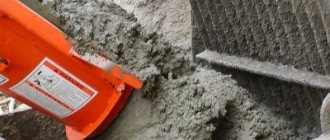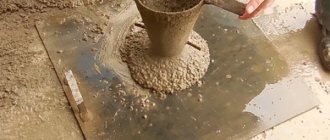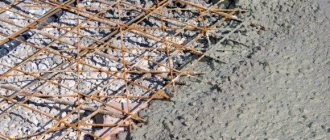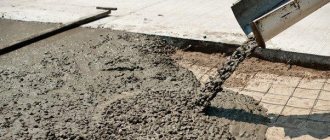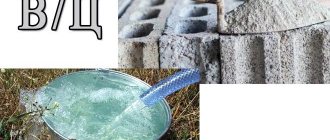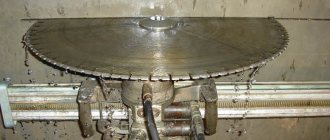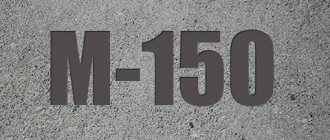What is needed to determine characteristics
There are several methods to obtain the test result. At the same time, workability is not directly determined by any of them. After all, the concept itself remains conditional. For different concretes, this property results in either rigidity or mobility. But several common instruments have been developed to obtain more or less accurate results.
- Cone slump is a method for testing concrete, relevant in the case of moving mixtures with low rigidity.
A special pouring mold is used, which is filled with materials. The main device is shaped like an Abrams cone.
The main material for the manufacture of such cones is sheet steel up to 300 millimeters high. The lower base will be 200 millimeters. The diameter of the upper base is 100. The installation location is a sheet with a fairly smooth surface. A metal rod is used for compaction. Including when we mean the Abrams cone.
- A technical viscometer is another device that is used in the case of rigid compounds.
The device is formed by metal molds and a vibration platform that has certain characteristics. For example, the amplitude of vibrations at the site itself is 0.35 millimeters. 2800-3000 is the approximate number of oscillations typical for most situations.
Standard cones are placed on the platform, and material is poured into them. They cannot do without metal bayonets used during pressing. Vibration action is necessary to finally secure the positions of the material.
- A simplified version of measurements is used in the case of solutions of high hardness.
The same vibration platform is used, but a metal cube-shaped form is mounted on it. Standard cones are installed inside the mold.
Test methods for hardened concrete
The main type of concrete testing, which is used for all types of structures, is concrete compressive strength testing. This indicator is indicated in the concrete labeling, which characterizes its importance.
There are two independent methods of strength testing. These are laboratory tests of concrete for strength before sending the finished material to the site and testing the strength of a specific hardened material directly on the construction site. At the same time, for especially critical structures, based on the test results, a concrete strength test report is drawn up, which indicates the data obtained and the date of the test.
Let's consider both methods in more detail. The procedure for testing concrete for strength by laboratory methods is regulated by the requirements of a regulatory document - the current standard GOST 10180-2012. The essence of the method is simple, and consists in making cubic or cylindrical samples of a certain size.
The dimensions of the cubes for testing concrete are also determined by the requirements of the specified GOST and constitute concrete elements with edge lengths of 100, 150, 200, 250 and 300 millimeters. Cylindrical samples for strength testing can have a diameter of 100, 150, 200, 250 and 300 millimeters.
After pouring the samples and holding them for a certain time, the sample is destroyed using a social press. In this case, the mathematical value of the destructive force is recorded, which characterizes the compressive strength of concrete. This is a very accurate, but not always acceptable method.
Construction cannot wait for concrete samples to set and gain brand strength. Therefore, construction companies use empirical methods for testing concrete strength in their practice. These methods are divided into two main groups: partially destroying concrete and non-destructive concrete.
The partial destruction technology is the most reliable method and, according to the requirements of regulatory documents, is mandatory when putting a building into operation. The technical essence of the partial destruction technology is the adhesive fixation of a special steel disk on the surface of the structure being tested.
Next, using a special device, the disk is torn off along with a piece of concrete. The magnitude of the tearing force is recorded by a special device - this is the strength value of a given concrete structure.
Sampling of concrete mixture
Any testing process begins with someone taking certain samples. One of the following persons may be responsible for such work:
- Laboratory assistant.
- Master.
- Foreman of the relevant section.
The number of samples determines the volume of planned concrete placement. The samples are divided into series, each of which contains three samples. In this case, the time gap in each series should be minimal. It does not matter which cone is used for testing.
Based on the volume of work, the following examples of calculating the number of series can be given:
- If the facility is put into operation 28 days after laying the mortar or earlier, 2-3 series are needed.
- For 20 cubic meters of solution, 1 series is taken when talking about frame structures.
- For 50 cubic meters of solution, take 1 series if you are working with massive foundations for installing equipment. For each individual foundation, 1 series is taken; the cone for checks does not matter.
- One series of samples per 100 cubic meters of solution - for ordinary massive structures.
I make control samples to check the compressive strength. GOST 10180 is a document whose requirements are important to comply with during further installation and operation. However, in the case of making samples, the work order does not change. It doesn’t matter what technologies are used during delivery and installation, or what cone is chosen for the procedure.
Before taking samples, you need to make sure that there are no traces of old materials left on the inner walls. To prevent setting, treatment with special oils is used. When filled and stored in forms, finished samples should not be deformed. For rib sizes it is prohibited to have deviations of more than 1%. Ready-made forms additionally carry out integrity checks. Then, due to the loss of liquid, the solution will not change its properties.
In this case, it is necessary to take into account the limited time that is given for sampling. Samples should be containerized and compacted no later than 20 minutes after initial collection. If necessary, the solution can be laid in two identical layers, with simultaneous bayoneting to the bottom of the molding containers.
Only one layer is used when high mobility is involved. Each layer inside the container must be pinned to the same depth. The main thing is to follow the norm. It sounds like this - 10 passes of the rod over 100 square centimeters of surface inside the mold. If excess solution occurs, it is removed, and then the surface is finally smoothed so that the cone shrinks correctly.
Filling the mold requires vibration if solutions with highly mobile, plastic properties are prepared for testing. Moreover, if vibration methods were also used during the initial installation. One of the options for solving the problem is using vibrating platforms.
Vibration affects the solution until its movement under this influence stops. The shrinkage period is measured using a stopwatch. If shrinkage has stopped, part of the cement composition will come to the surface. After this, the horizontal surface is leveled. Certain aspects of the technology may depend on the specific mixture and its hardness.
Conducting experiments
As already mentioned, there are several methods to determine the exact result.
The work order can be described separately, in more detail.
- With the cube method, an area of 10 or 15 centimeters is filled. Thanks to this, the grade of concrete mixture is determined more quickly based on workability.
They wait for some time until the material takes a cubic shape. After the base has completely hardened, it is sent to the laboratory. This method has a lot of disadvantages; it takes too much time and requires money. The solution is unlikely to be justified in low-rise construction.
- A plastometer is another option, but it also has a high price. And it changes the workability of the concrete mixture.
The purchase and use of such a device will be justified during a large construction project, when tests are carried out constantly. Another thing is low-rise construction, when owners encounter the relevant work only 1-2 times in their lives.
The cone method is the simplest option available to any user ( according to GOST 10181-2014 Concrete mixtures. Test methods. ), even with minimal skills and training. You need to take a cone, usually made of metal. Industrial and civil production require the use of products with standardized dimensions. There are separate factories that specialize in the production of equipment.
To determine the mobility of a concrete mixture, use:
- normal or enlarged cone;
- metal ruler;
- loading funnel;
- trowel type KB;
- stopwatch;
- a smooth hard sheet with dimensions of at least 700x700 mm made of waterproof material (metal, plastic, etc.);
- straight metal smooth rod with a diameter of 16 mm, a length of 600 mm with rounded ends.
The workability grades of concrete P4 and P5 (the most common grades for ready-mix concrete) are determined by filling the cone in one step and bayoneting it 10 times in a normal cone, and 20 times in an enlarged one.
At the last stage, the cone is turned over onto a flat surface. The structure is removed from the mass. The concrete dough begins to settle under the pressure of its own weight. The mobility of the material is determined by how much shrinkage has occurred in centimeters.
Incoming control of concrete mixture
Incoming inspection of concrete mixtures
Concrete mix -
It is a ready-to-use mixed homogeneous mixture of inorganic binder, aggregates and water with or without the addition of chemical and mineral additives, which after compaction, setting and hardening becomes concrete.
Based on the type of concrete, concrete mixtures are divided into:
- concrete mixtures of heavy concrete (BCT);
- concrete mixtures of fine-grained concrete (FMC);
- concrete mixtures of lightweight concrete (LBC).
The symbol for a concrete mixture of a given quality when ordering should consist of the abbreviation B - concrete strength class, SZh, Zh, P, P - grade of concrete mixture for workability and, if necessary, other standardized quality indicators, for example F- grade for frost resistance, W- grades for water resistance, average concrete density, percentage of entrained air, etc.
Concrete mixtures are accepted in batches, which include concrete mixtures of the same nominal composition, prepared from the same materials using the same technology.
Each batch of concrete mixture must have a quality document (passport), which, in addition to markings and symbols, must display the parameters of acceptance and periodic tests.
Mix selection
A sample of the concrete mixture for testing is taken immediately before the start of concreting from the middle part of the batch or portion of the mixture. With a continuous supply of concrete mixture (belt conveyors, concrete pumps), samples are taken in three steps at random times for no more than 10 minutes.
The temperature of the concrete mixture from the moment of sampling to the end of the test should not change by more than 5 °C.
The storage conditions for the concrete mixture sample after its collection until testing must prevent loss of moisture or wetting.
Testing of the concrete mixture and production of control concrete samples should begin no later than 10 minutes after sampling.
Production of control samples
The strength of concrete at the age of 7 and 28 days is determined using control samples, which are made and tested in batches. The number of samples depends on the intra-series coefficient of variation, and their sizes and shape depend on the method for determining the strength of concrete; mainly, when testing compression, cubes with an edge length of 100 mm are used.
To make samples, at least two samples of concrete mixture are taken from each batch and at least one sample per shift. The mixture is placed in a mold and compacted with a bayonet no later than 20 minutes after selection.
Control samples intended for hardening under normal conditions, after manufacturing and before stripping, should be stored in forms covered with a damp cloth or other material that excludes the possibility of evaporation of moisture from them, in a room with an air temperature of (20 ± 5) ° C.
Specimens intended for hardening under conditions similar to the conditions for hardening concrete in monolithic structures can be hardened either in forms or in stripped form.
Determination of workability of concrete mixture
Depending on the workability indicator, concrete mixtures are divided into groups: super-hard (SZ), hard (R), mobile (P) and spreading (R). The groups are divided into brands according to workability.
The workability of a concrete mixture is assessed by indicators of mobility or rigidity.
The mobility of a concrete mixture is assessed by the slump (SK) or spread (RK) of a cone molded from a concrete mixture.
To do this, use an Abrams Cone, a loading funnel, a steel ruler, a trowel, a smooth sheet of metal and a straight metal rod with a diameter of 16 mm with rounded ends.
To determine the mobility of a concrete mixture with aggregate grains of the largest size (up to 40 mm inclusive), a normal cone is used, and with grains of the largest size of more than 40 mm, an enlarged one is used.
When preparing the cone and fixtures for testing, all surfaces in contact with the concrete are cleaned and moistened.
The cone is placed on a smooth horizontal metal sheet and filled with a concrete mixture of grades P1, P2 or P3 through a funnel in three layers of the same height. Each layer is compacted to its height by bayoneting with a metal rod, in a normal cone - 25 times, in an enlarged cone - 56 times. The cone is filled with a concrete mixture of grades P4 and P5 in one step and bayoneted 10 times to the entire height of the cone.
After compacting the concrete mixture, the funnel is removed, the excess mixture is cut off with a trowel flush with the upper edges of the cone, and the surface of the concrete mixture is smoothed. Then the cone is smoothly removed from the molded concrete mixture in a strictly vertical direction and installed next to it. The time spent raising the cone should be 5-7 seconds.
The slump of the concrete mixture cone is determined by placing a smooth rod on the top of the form and measuring the distance from the bottom surface of the rod to the top of the concrete mixture with an error of no more than 0.5 cm.
The spread of a concrete mixture cone is determined by measuring the diameter of the spread cake with a metal ruler in two mutually perpendicular directions with an error of no more than 0.5 cm.
In accordance with GOST 7473-2010, grades based on cone draft are divided into:
P1 – 1-4 cm, P2 – 5-9 cm, P3 – 10-15 cm, P4 – 16-20 cm, P5 – More than 20 cm
According to the spread of the cone to:
P1 less than 35 cm, P2 – 35-41 cm, P3 – 42-48 cm, P4 49-55 cm, P5 56-62 cm, P6 – More than 62 cm.
Processing the results
The test results usually determine whether the structure can be operated with the loads specified in the original design. If strength and other indicators are too low, additional measures are taken to strengthen the structures. They are developed in advance. In this case, concrete can undergo several processing methods:
- With the help of steam. It can also affect the workability of the concrete mixture.
- When the surface is watered.
The supplier sets the price of its own products when it independently carries out the necessary tests. During transportation, materials often change their original properties, so everyone involved in sales carries out repeated tests. For them, determining the workability of a concrete mixture is also important.
The tests also take into account other characteristics:
- Waterproof.
- Frost resistance.
- Deformations.
- By stretching.
What is cone draft?
Typically, the slump of a concrete cone is defined as a numerical designation, with centimeters as the unit of measurement. The indicator shows how much the concrete sinks after removing the cone and any other shapes. Thanks to this, within one classification group it is easier to separate one brand from another based on plasticity. For example, the mixture is definitely highly mobile if the shrinkage is more than 5 centimeters. Group P-3 includes materials with a concrete cone settlement of 10-15 centimeters. Next comes P4.
How to determine plasticity? Cone settlement method.
There are several methods for determining the plasticity of concrete
. Let's look at some of them.
- Monolith Analysis
To check, take several cube-shaped boxes with a side length of 10-15 cm. The molds are moistened inside and placed on a flat area. Next, concrete is poured there and compacted. The mixture dries for about a month. The resulting samples are then sent to a laboratory for testing.
- Method of conducting experiments in forms
To determine plasticity, a cone-shaped mass of concrete is placed inside a hollow cube. Next, the form is placed on the included vibrating plate. Then, using a stopwatch, determine the period of time during which the concrete filled all the corners of the cube. The resulting number is multiplied by a factor of 0.7.
- Cone settlement method
This method of determining plasticity is most often used. The Abrams cone is used for testing. You can purchase it at industrial equipment stores. It is sold together with a funnel for pouring the mixture and a bayonet for compacting it.
- To carry out the tests, the cone is placed on a 70x70cm wooden or metal shield. The inside of the mold is moistened with water.
- Next, the concrete mixture is fed into the cone in layers. Each layer must first be compacted, only then can the next one be poured.
- After laying and compacting the concrete, the excess is cut off using a trowel.
- After 3 minutes, the mold is smoothly removed.
- The size of the concrete cone is compared with the height of the metal one. The difference between these parameters determines mobility.
If you want to know the mobility in advance, it is better to order concrete from a manufacturer with many years of experience. Thus, the recipes will be worked out many times, and therefore the properties of the material will be exactly according to GOST.
About the use of regulators for the consistency of mixtures
Consistency regulators are used to dilute the original composition. Such regulators are also called plasticizers . Depending on their characteristics, the settlement of the concrete cone can vary by 2-6 centimeters up or down. In this case, the loss of strength will be no more than 5%.
Plasticizers are divided into two main types:
- Dry mixtures, usually accounting for up to 5-20% of the total volume.
- Types of liquid superplasticizers. Their number ranges from 0.1% to 1.5%.
The first types have more affordable prices. Examples of these include the following materials:
- Lingosulfonates.
Brown powders. The composition is a mixture that includes ligosulfite acids and sodium salts. Additionally there are mineral additives.
- Paper production waste. Example - SDB or Sulfite-yeast mash.
- A synthetic version of the SDB additive. The most proven and cheapest option, also distinguished by low prices. Of the total volume, the amount of this additive averages up to 10%. But the setting time of concrete together with this material is longer. Therefore, it is better to choose types of mixture to which other components are added to reduce the negative effects. Or used for situations where there are no special requirements for the setting time and mobility of concrete.
Complex regulators of the state of concrete mixtures are a liquid form of plasticizers. Such materials are more expensive compared to powders, but much less is required. Various versions of formaldehyde resins are the main components in the composition.
measurement of cone settlement in centimeters when testing the mobility of concrete mixture P4 P5
At the same time, liquid varieties of materials provide other advantages:
- Reduced cement consumption. The spreading of the concrete mixture cone does not affect this.
- Increasing attractiveness in appearance.
- Increased structural strength.
- Possibility of using even low-flow mixtures for pouring reinforcement.
- Increased frost resistance of the final product.
- Increasing the overall mobility of the composition when the concrete is tested with a cone.
Reducing the setting time of the mixture is the only drawback inherent in the materials. Forming the mixture in the formwork must be completed literally 2-3 hours after the addition of the additive. The main thing is to do the work carefully so as not to damage the equipment or waste the material itself.
After the test, it becomes easier to understand how and under what conditions to use the compositions further. Is the base fluid enough when pouring certain shapes and structures? The answer to this question can be obtained quite quickly. The letter P is most often used to classify compositions based on the main feature - mobility. It explains not the aggregate state of materials, but the degree of elasticity inherent in mixtures.
How to restore the mobility of a concrete mixture? Never use water. You will only reduce the final strength of the concrete. For these purposes, it is possible to use a plasticizer. It is administered only by a laboratory representative to a known volume of the mixture.
General information
What is concrete mix? This is a rationally formulated and thoroughly mixed solution of components before the setting and hardening period begins. The composition of the mixture is calculated taking into account the requirements for the solution itself and the operational characteristics of future structures.
Properties
The formation of the operational characteristics of concrete structures begins with the preparation, laying and technologically correct hardening of the mixture.
These processes largely determine the future quality of reinforced concrete products.
- Therefore, it is very important to know the properties and behavior of the concrete mixture, its dependence on various factors, and skillfully manage the procedure for preparing, laying and setting concrete.
- The main property of concrete mortar is its formability or workability - that is, the ability of the composition to spread and take the required shape, while maintaining uniformity and solidity (see video in this article).
- Workability is determined by the fluidity (mobility) of the mixture during the period of filling the formwork and plasticity - the ability to deform without changing the structure.
- The main influence on these parameters is the quality and quantity of the cement paste, as well as the water consumption used to prepare the solution. It is water that determines the structure of the liquid phase and the formation of adhesive forces that determine the mobility and coherence of the system.
- In its structure, the mixture is a homogeneous physical body in which grains of binder, water and filler particles are connected by internal interaction force. The main structure-forming component in the concrete composition is cement paste. As the hydration reaction of cement increases, the density of the solid phase increases and the binding capacity of the cement stone (solid) increases.
Note: Under the influence of ongoing processes, at a certain moment, the mixture overcomes its structural strength and begins to flow like a thick liquid. Therefore, concrete mortar is classified as an elastic viscous body that simultaneously has the properties of a liquid and a solid.
- The consistency of the mixture depends on the composition of the components, and can vary from a rigid form to a liquid, easily movable form.
- Determination of the mobility of a concrete mixture is determined using special equipment (more on this below). The criterion for mobility (workability) is the slump of the concrete mixture cone, on the basis of which conclusions are drawn about the state of a particular solution.
Workability according to GOST 7473-2010 is indicated by the letter “P” and has several meanings (table below).
Table of workability values - concrete mixture cone spreading (P1-P5)
The higher the grade, the more mobile the solutions. Grades P1-P3 are low-moving plastic compositions, and the mobility of concrete P4-P5 belongs to the category of very mobile mixtures.
conclusions
The mobility of concrete is a characteristic that seems complex only at first glance. It is easy not only to regulate thanks to additives, but also to initially determine it yourself. With modern technologies, it is possible to regulate the mobility of mixtures within fairly wide limits. The main thing is to monitor the latest trends related to this area. The price of additives should correspond to the final savings that appear when using them. And you need to choose your ingredients wisely. After reading about the components on the label, it is easier to decide what is suitable for what situation.
Determination of mobility
The figure above explains how you can determine the fluidity of the solution using a cone:
- a – type of cone;
- b – hard solution;
- c – sedentary;
- d – mobile mixture;
- d – very mobile solution;
- e – cast.
Such a study can visually show how concrete will be distributed in the formwork with the selected tamping technology with the parallel formation of a homogeneous and dense structure. Such parameters are called the workability of concrete mortar, which is assessed by the values of viscosity, plasticity and rigidity, and is determined according to the methods regulated by GOST 10181-2000. From the figure it is clear that the fluidity of concrete looks like the sediment of a cone and means the ability of the solution to spread under its own weight and gravity. Spreading is the main property that affects the admission of a material to the construction of a particular object.
Methods for determining the consistency of concrete mortar
The figure shows the general design of equipment for flow studies:
Figure “a” - determination of shrinkage by the mobility of the mixture using a cone:
- 1 – metal funnel;
- 2 – metal cone;
- 3 – stand;
- 4 – measuring ruler.
Figure “b” - how to determine the plasticity of concrete by its rigidity using a technical viscometer:
- I – research equipment;
- II – concrete before compaction by vibration;
- III – after compaction by vibration;
- 1 – steel ring;
- 2 – model cone;
- 3 – watering can;
- 4 – holder;
- 5 – metal plate with holes;
- 6 – tripod;
- 7 – vibration compactor platform.
Technologically, when using concrete mixtures of different viscosities, mobile concrete is classified according to GOST according to fluidity levels. The flowing mixture fills the reinforced formwork with complex geometry faster and more densely. Concrete in a liquid state is also divided into highly mobile and low-mobile. A low-flow mortar is a standard mixture without the addition of plasticizers, which is laid without compaction. The mobile one consists of a certain amount of plasticizers or is prepared with the addition of several synthetic components that ensure high fluidity of the mixture.
Strength chart
The workability of concrete is reflected in the following classification (workability table):
| Brand | Ease of use according to parameters: | ||
| Rigidity | Mobility | ||
| cone draft | Cone blur | ||
| Super hard solution | |||
| SZh-3 | ≥ 100 | – | – |
| SZh-2 | 51-100 | – | – |
| SZh-1 | ≤ 50 | – | – |
| Hard solution | |||
| Zh-4 | 31-60 | – | – |
| Zh-3 | 21-30 | – | – |
| Zh-2 | 11-20 | – | – |
| Zh-1 | 5-10 | – | – |
| Mobile solution | |||
| P-1 | ≤ 4 | 1-4 | – |
| P-2 | – | 5-9 | – |
| P-3 | – | 10-15 | – |
| P-4 | – | 16-20 | 26-30 |
| P-5 | – | ≥ 21 | ≥ 31 |
The delamination properties of heavy and lightweight concrete are shown in the table below:
| Brand of mixture | Delamination coefficient in %, ≤ | ||
| Moisture separation | Concrete separation | ||
| Heavy concrete | Lightweight concrete | ||
| SZh-3 – SZh-1 | ≤ 0,1 | 2,0 | 3,0 |
| Zh-4 – Zh-1 | ≤ 0,2 | 3,0 | 4,0 |
| P-1 – P-2 | ≤ 0,4 | 3,0 | 4,0 |
| P-3 – P-5 | ≤ 0,8 | 4,0 | 6,0 |
The mobility of a concrete mixture not only differs in the fillability of the form, but also depends on the proportions of binders, the quality and quantity of components, the brand of Portland cement, the density of the composition, the volume of water and plasticizers, and the granularity of fillers (crushed stone, gravel, sand, lime). The last thing that influences fluidity is the technology of pouring the solution into the formwork.
Water demand and water release schedule
When pouring the mixture into formwork densely filled with reinforcement, it is necessary to prepare a solution with increased fluidity, since it will be impossible to compact such concrete with vibrators, even deep ones. If the fluidity is lower than recommended, then pores and cavities will certainly form in the structure, which will reduce the strength of the object.
